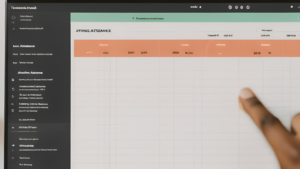
Present Simple Tense 1
English Blogs “Let’s Learn, Explore, and Connect to the World” Present Simple Tense 1 I. Introduction to the Present Simple Tense in English Mastering the


 Just like a well-oiled machine, employee success hinges on strong mental well-being. When their minds are healthy, they can thrive both on and off the job. In the workplace, mental health affects how individuals think, feel, and act, influencing their ability to handle stress, relate to colleagues, and make decisions. When mental health issues such as stress, anxiety, or depression are prevalent, they can lead to decreased productivity, higher absenteeism, and increased turnover rates. Flip the switch on employee performance! Fostering a culture of mental well-being leads to a surge in engagement, motivation, and productivity.
Just like a well-oiled machine, employee success hinges on strong mental well-being. When their minds are healthy, they can thrive both on and off the job. In the workplace, mental health affects how individuals think, feel, and act, influencing their ability to handle stress, relate to colleagues, and make decisions. When mental health issues such as stress, anxiety, or depression are prevalent, they can lead to decreased productivity, higher absenteeism, and increased turnover rates. Flip the switch on employee performance! Fostering a culture of mental well-being leads to a surge in engagement, motivation, and productivity.
It’s not just the right thing to do, it’s smart business: prioritizing mental well-being creates a win-win for employee morale and the company’s bottom line. A workplace prioritizing mental health fosters a culture of openness and support, which can enhance employee satisfaction and loyalty. This supportive culture can also attract top talent, increasingly prioritizing mental health and work-life balance when choosing employers.
 Moreover, addressing mental health proactively can lead to substantial economic benefits. A healthier workforce translates to a stronger bottom line. Fewer sick days, lower healthcare burdens, and increased productivity all contribute to the company’s financial well-being. Companies investing in mental health initiatives can expect a return on investment through a more resilient and capable workforce. Therefore, fostering a supportive mental health environment is essential for employee well-being and organizational success.
Moreover, addressing mental health proactively can lead to substantial economic benefits. A healthier workforce translates to a stronger bottom line. Fewer sick days, lower healthcare burdens, and increased productivity all contribute to the company’s financial well-being. Companies investing in mental health initiatives can expect a return on investment through a more resilient and capable workforce. Therefore, fostering a supportive mental health environment is essential for employee well-being and organizational success.
 Work isn’t just about building a wall, it’s about having strong foundations. Mental health is the bedrock that supports employee performance. A healthy mind fosters focus, resilience, and the ability to tackle challenges effectively. It includes emotional, psychological, and social well-being, impacting how employees think, feel, and behave. In this context, key aspects of mental health include managing stress, maintaining work-life balance, and fostering a positive work environment.
Work isn’t just about building a wall, it’s about having strong foundations. Mental health is the bedrock that supports employee performance. A healthy mind fosters focus, resilience, and the ability to tackle challenges effectively. It includes emotional, psychological, and social well-being, impacting how employees think, feel, and behave. In this context, key aspects of mental health include managing stress, maintaining work-life balance, and fostering a positive work environment.
Common mental health issues faced by employees include:
 Recognizing these issues and their impact on employees’ well-being and productivity is crucial for creating a supportive work environment.
Recognizing these issues and their impact on employees’ well-being and productivity is crucial for creating a supportive work environment.
 Imagine a workforce where stress casts a long shadow, sapping productivity by a trillion dollars globally each year [reference WHO statistic]. In the US alone, millions bring their mental health battles to work every day [reference NIMH statistic]. It’s clear: mental well-being is no longer a personal concern, it’s a pressing business issue.
Imagine a workforce where stress casts a long shadow, sapping productivity by a trillion dollars globally each year [reference WHO statistic]. In the US alone, millions bring their mental health battles to work every day [reference NIMH statistic]. It’s clear: mental well-being is no longer a personal concern, it’s a pressing business issue.
The COVID-19 pandemic has significantly impacted workplace mental health, exacerbating existing issues and creating new challenges. Remote work, social isolation, job insecurity, and health concerns have increased stress and anxiety levels among employees. A study by the American Psychological Association (APA) found that nearly 70% of employees reported increased stress levels during the pandemic.
Trends over recent years indicate a growing awareness and prioritization of mental health in the workplace. Gone are the days of ignoring mental health. Today’s smart companies are taking a stand with initiatives like mental health days, employee support programs, and comprehensive wellness resources, recognizing their employees’ well-being is key to success. Additionally, a shift towards creating more flexible work environments allows employees to better manage their work-life balance.
 Mental health in the workplace isn’t a one-time fix, it’s a continuous conversation. We need to keep our finger on the pulse of employee well-being, staying informed about current trends and the range of challenges they face. This awareness is the foundation for creating a supportive environment that promotes the well-being and productivity of all employees.
Mental health in the workplace isn’t a one-time fix, it’s a continuous conversation. We need to keep our finger on the pulse of employee well-being, staying informed about current trends and the range of challenges they face. This awareness is the foundation for creating a supportive environment that promotes the well-being and productivity of all employees.

Work shouldn’t feel like a pressure cooker. When workplaces prioritize mental health, they cultivate a supportive environment that nourishes employee well-being. It’s a win-win – a culture of care leads to happier, healthier workers. When employees feel supported, they are more likely to experience reduced stress levels, better mental clarity, and improved emotional resilience. For instance, companies implementing comprehensive mental health programs often see positive impacts on their workforce. Google, known for its strong emphasis on employee well-being, provides mental health resources, flexible work schedules, and wellness programs. This approach has not only improved the well-being of their employees but also enhanced their overall job satisfaction and engagement.
Another example is the implementation of Employee Assistance Programs (EAPs), which offer counseling services, mental health resources, and support for personal issues. Don’t wait for burnout! These impactful programs equip employees with the tools they need to manage stress, balance work and life demands, and proactively build a foundation for lasting well-being.

There is a strong correlation between mental health support and employee productivity. Employees who are mentally healthy are more focused, creative, and efficient. Studies have demonstrated that supportive work environments lead to higher productivity levels. For example, a study by the World Health Organization (WHO) found that for every dollar invested in treating common mental health issues, four dollars are returned in improved health and productivity.
Moreover, supportive environments encourage open communication and collaboration, leading to innovative problem-solving and increased job performance. Companies like Microsoft have seen enhanced productivity by fostering a culture of inclusivity and mental health awareness, resulting in employees feeling more valued and motivated to contribute effectively.

Mental health initiatives are crucial in reducing turnover rates and increasing employee satisfaction. When employees feel their mental health is prioritized, they are more likely to stay with the company and develop a sense of loyalty. A supportive environment reduces the likelihood of burnout and turnover, saving companies the cost and disruption of frequent recruitment.
Research shows that employees who perceive their workplace as supportive are more satisfied with their jobs. For example, Johnson & Johnson’s comprehensive mental health initiatives have resulted in high employee retention rates and satisfaction. The company’s focus on mental well-being has fostered a loyal and committed workforce.
In conclusion, the benefits of a supportive work environment extend beyond individual well-being. They encompass improved productivity, better job performance, and higher employee retention and satisfaction. Companies that invest in mental health support are likely to see significant positive outcomes in both employee well-being and overall business performance.

Building a supportive work environment starts with a strong foundation. Clear and inclusive mental health policies lay the groundwork for a culture that prioritizes employee well-being. These policies should outline the company’s commitment to mental health, provide guidelines for recognizing and addressing mental health issues, and ensure confidentiality and support for affected employees. Smart mental health policies go beyond words. They empower employees with the tools they need to thrive, offering options like flexible work arrangements, reasonable accommodations, and easy access to mental health resources. It’s a win-win for both employee well-being and company success.
For example, Unilever has implemented a comprehensive mental health policy that includes mental health training for managers, employee assistance programs (EAPs), and initiatives to reduce the stigma around mental health issues. This policy has improved mental health awareness and support across the organization, demonstrating the importance of clear and actionable policies.

Training and education are crucial for raising awareness and equipping employees and management with the skills needed to support mental health. Training programs should focus on identifying signs of mental health issues, providing appropriate support, and promoting a culture of understanding and empathy. Leaders are the lighthouse, guiding the way. Investing in management training on mental health is crucial. Equipped leaders can create a ripple effect, fostering a supportive culture and empowering teams to prioritize well-being.
Regular, ongoing education ensures that mental health remains a priority and that all employees are informed about available resources and support mechanisms. Companies like PwC offer mental health first aid training to their employees, teaching them how to respond to mental health crises and support their colleagues effectively. This continuous education fosters a knowledgeable and supportive workforce.

Silence is the enemy of well-being. Building a truly supportive environment hinges on open communication. When employees feel safe talking about their mental health, the walls of stigma crumble, paving the way for a culture of care and support. Tools and methods for fostering open communication include regular check-ins, anonymous feedback channels, and mental health forums or support groups.
Vulnerability is the new strength. When leaders and employees step up and share their mental health journeys, it breaks the ice. These open conversations normalize mental health struggles, creating a safe space for everyone to seek and offer support. For instance, Bell Canada’s “Let’s Talk” initiative encourages employees to speak openly about mental health, significantly reducing stigma and promoting a supportive workplace culture. Effective communication channels ensure employees feel heard and supported, which is crucial for their mental well-being.

Providing accessible mental health resources and support is essential for a supportive work environment. Resources, counseling services, mental health days, and wellness programs offer crucial support for employees facing mental health challenges. It is important to ensure these resources are easily accessible and employees are encouraged to use them.
Promoting these resources through regular communication, workshops, and mental health awareness campaigns can help increase their utilization. For example, Deloitte offers a comprehensive EAP that includes counseling services, stress management workshops, and access to mental health professionals. Don’t let resources gather dust! Having great mental health resources is just the first step. Making sure they’re well-promoted, easily accessible, and free of stigma is crucial. Employees won’t benefit from what they don’t know exists, so let’s bridge that gap and unlock the power of well-being support.
Building a mentally healthy workplace isn’t a one-time project, it’s an orchestra with many instruments. Inclusive policies are the sheet music, ongoing training refines the skills, open communication creates harmony, and accessible resources are the instruments themselves. By playing all these parts together, we can create a beautiful symphony of employee well-being. These strategies collectively contribute to a healthier, more productive, and engaged workforce, ultimately benefiting employees and the organization.

Leaders are crucial in promoting mental health by leading by example. When leaders prioritize their mental health, it sets a powerful precedent for employees. Be the change you want to see! Leaders who openly embrace self-care, take mental health days, and seek help when needed, send a powerful message. This normalizes these practices for everyone, chipping away at stigma and encouraging employees to prioritize their well-being without fear. It’s a domino effect – healthy leaders foster healthy teams.
Leaders who actively support mental health initiatives can significantly impact the workplace culture. By championing mental health programs, participating in mental health training, and visibly supporting mental health campaigns, leaders send a clear message that mental health is a priority. This proactive involvement builds trust and fosters a sense of safety and support among employees.

Promoting inclusivity is another essential role for leaders in supporting mental health. Inclusive workplaces where diversity is valued and respected can significantly improve mental health outcomes for employees. Leaders can promote inclusivity by implementing policies encouraging diversity and ensuring that all employees feel valued and included. Strategies include:


Diversity strengthens minds, minds strengthen diversity. Workplaces that embrace a rich tapestry of backgrounds create a win-win for mental health. Employees feel less isolated and discriminated against, fostering a sense of belonging that encourages open conversations about mental health. It’s a powerful cycle – a supportive environment empowers diverse voices, and those voices, in turn, enrich and strengthen the culture of well-being.
Burnout is a significant issue that leaders must be vigilant about. Recognizing signs of burnout—such as decreased productivity, increased absenteeism, and emotional exhaustion—is critical. Leaders aren’t mind readers, but they can become mental health champions! Equipping them with training to recognize potential signs of struggle empowers them to approach employees with empathy and support. By becoming attuned to their team’s well-being, leaders can act as a first line of defense and connect employees with the resources they need.
Effective interventions to prevent and address burnout include:



Stop burnout before it starts! Proactive leaders who recognize and address early signs of burnout can nip this issue in the bud. This creates a ripple effect – a healthier, more sustainable work environment for employees translates to a more productive and resilient workforce for the company. It’s a win-win for everyone. This enhances employee well-being and contributes to higher productivity and job satisfaction.
 In conclusion, leadership’s role in promoting mental health is multifaceted and crucial. By leading by example, fostering an inclusive culture, and effectively recognizing and addressing burnout, leaders can significantly improve their employees’ mental health and overall well-being.
In conclusion, leadership’s role in promoting mental health is multifaceted and crucial. By leading by example, fostering an inclusive culture, and effectively recognizing and addressing burnout, leaders can significantly improve their employees’ mental health and overall well-being.
 We can’t improve what we don’t measure! Setting clear and measurable goals for mental health initiatives is like having a roadmap. It allows us to track progress, see what’s working, and continuously refine our efforts to cultivate a thriving workplace for everyone’s well-being. These goals provide a framework for assessing progress and identifying areas for improvement.
We can’t improve what we don’t measure! Setting clear and measurable goals for mental health initiatives is like having a roadmap. It allows us to track progress, see what’s working, and continuously refine our efforts to cultivate a thriving workplace for everyone’s well-being. These goals provide a framework for assessing progress and identifying areas for improvement.
Examples of benchmarks for mental health initiatives include:




By establishing these benchmarks, organizations can set realistic targets and measure their progress.
Regular assessments are crucial for understanding the effectiveness of mental health programs. To gauge the impact of our mental health initiatives, we can tap into a toolbox of assessment methods:



Continuous improvement is essential, and feedback from employees plays a pivotal role in this process. Listening to employees’ concerns and suggestions helps organizations tailor their mental health initiatives to better meet their needs.
 Using assessment data to refine and improve mental health initiatives is crucial for their long-term success. Organizations should adopt a data-driven approach to make informed decisions about their mental health strategies. This involves:
Using assessment data to refine and improve mental health initiatives is crucial for their long-term success. Organizations should adopt a data-driven approach to make informed decisions about their mental health strategies. This involves:
Case studies are like treasure troves, holding valuable insights into successful adjustments made by other companies. By studying their wins, we can avoid reinventing the wheel and accelerate our own journey towards a thriving workplace that prioritizes mental health. For example, a tech company might find through surveys that their employees are experiencing high levels of burnout. In response, they implement flexible work schedules and offer additional mental health resources. Subsequent assessments show a significant decrease in burnout symptoms and improved employee well-being.
 In conclusion, measuring the impact of mental health initiatives involves setting clear goals, conducting regular assessments, and using data to make informed adjustments. This approach ensures that mental health programs are effective, responsive, and continuously improving, ultimately fostering a healthier, more productive workplace.
In conclusion, measuring the impact of mental health initiatives involves setting clear goals, conducting regular assessments, and using data to make informed adjustments. This approach ensures that mental health programs are effective, responsive, and continuously improving, ultimately fostering a healthier, more productive workplace.

English Blogs “Let’s Learn, Explore, and Connect to the World” Present Simple Tense 1 I. Introduction to the Present Simple Tense in English Mastering the

English Blogs “Let’s Learn, Explore, and Connect to the World” Present Simple Tense 2 II. Understanding the Present Simple Tense Definition and Structure At its
Discover the joy of conversation with “Comic Collections: A Compilation of Daily Professional and Casual Conversations,” a whimsically illustrated comic book that transforms talking into an adventure. Ideal for those eager to polish their chatting skills, this light-hearted guide is a trove of insights presented in a uniquely entertaining format.



